Vanguard CT-7000 S2 User Manual
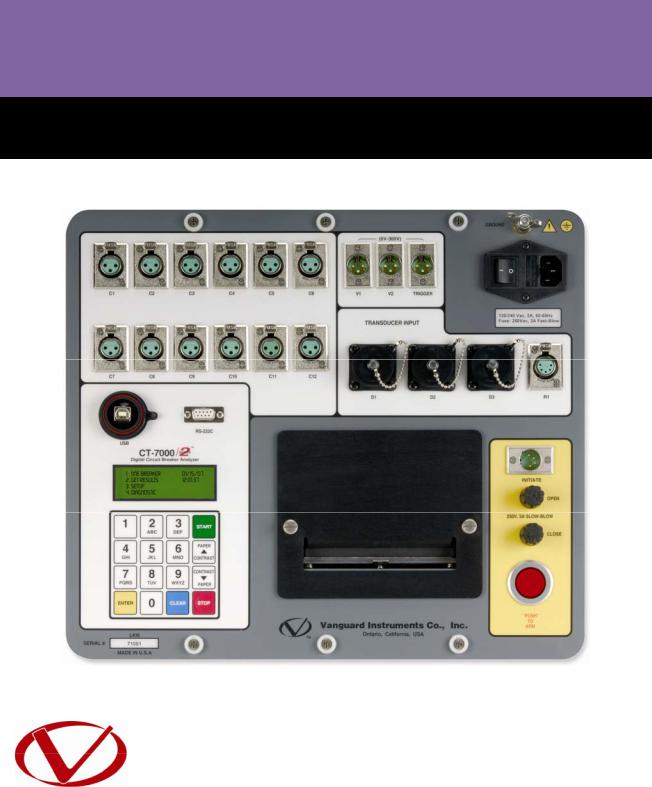
CT-7000 S2TM
DIGITAL CIRCUIT BREAKER ANALYZER
USER’S MANUAL
Vanguard Instruments Company, Inc.
1520 S. Hellman Ave.
Ontario, California 91761, USA
TEL: (909) 923-9390 |
February 2011 |
FAX: (909) 923-9391 |
Revision 2 |
|
|

CT-7000 S2 USER’S MANUAL REV 2
SAFETY SUMMARY
FOLLOW EXACT OPERATING PROCEDURES
Any deviation from the procedures described in this User’s Manual may create one or more safety hazards, may damage the CT-7000 S2, or cause errors in the test results. Vanguard Instruments Company, Inc. assumes no liability for unsafe or improper use of the CT-7000 S2.
All safety precautions provided in this manual must be observed during all phases of testing including test preparation, test lead connection, actual testing, and test lead disconnection.
SAFETY WARNINGS AND CAUTIONS
Only trained operators shall use the CT-7000 S2. All devices under test shall be off-line and fully isolated. Do not perform test procedures or service unless another person is also present who is capable of rendering aid and resuscitation.
DO NOT MODIFY TEST EQUIPMENT
To avoid the risk of introducing additional or unknown hazards, do not install substitute parts or perform any unauthorized modification to any CT-7000 S2 test unit. To ensure that all designed safety features are maintained, it is highly recommended that repairs be performed only by Vanguard Instruments Company factory personnel or by an authorized repair service provider. Unauthorized modifications can cause safety hazards and will void the manufacturer’s warranty.
WARNING
Do not remove test leads during a test. Failure to heed this warning can result in electrical shock to personnel and damage to the equipment.
i

REV 2 CT-7000 S2 USER’S MANUAL
TABLE OF CONTENTS
CONVENTIONS USED IN THIS DOCUMENT ..................................................................................... |
1 |
|||
1.0 |
INTRODUCTION.................................................................................................................... |
2 |
||
1.1 |
General Description and Features ................................................................................... |
2 |
||
1.2 |
Technical Specifications ................................................................................................... |
4 |
||
1.3 |
CT-7000 S2 Controls and Indicators................................................................................. |
5 |
||
2.0 |
PRE-TEST SETUP ................................................................................................................... |
7 |
||
2.1 |
Operating Voltages .......................................................................................................... |
7 |
||
2.2 |
LCD Screen Contrast Control............................................................................................ |
7 |
||
2.3 |
Printer Paper Control....................................................................................................... |
8 |
||
2.4 |
Printer Paper.................................................................................................................... |
8 |
||
3.0 |
OPERATING PROCEDURES ................................................................................................... |
9 |
||
3.1 |
Cable Connections ........................................................................................................... |
9 |
||
3.1.1. |
Contact Cable Connections ...................................................................................... |
9 |
||
3.1.2. |
Initiate Cable Connections ..................................................................................... |
11 |
||
3.1.3. |
Analog and Digital Voltage Monitoring Connections............................................. |
13 |
||
3.1.4. |
External Trigger Input Connections........................................................................ |
14 |
||
3.1.5. |
Digital Transducer Connection ............................................................................... |
15 |
||
3.1.6. |
Resistor Type Transducer Connection.................................................................... |
16 |
||
3.1.7. Pre-Test Setup................................................................................................................ |
17 |
|||
3.1.8. |
Entering Test Record Header Information ............................................................. |
17 |
||
3.1.9. |
Setting the Clock..................................................................................................... |
20 |
||
3.1.10. |
Configuring the Automatic Printing Feature .......................................................... |
21 |
||
3.1.11. |
Setting the Units of Measure ................................................................................. |
22 |
||
3.1.12. |
Setting the Open Timing Analysis Points................................................................ |
23 |
||
3.1.13. |
Selecting the Contact Cycle Reading Frequency .................................................... |
27 |
||
3.1.14. |
Configuring the Channel Settings........................................................................... |
30 |
||
3.1.15. |
Configuring the Contact Filter Settings .................................................................. |
32 |
||
3.1.16. |
Configuring the Transducer Encoder Filter Setting ................................................ |
34 |
||
3.1.17. |
Configuring the Digital Rotary Transducer Settings ............................................... |
36 |
||
3.1.18. |
Configuring the Resister Type Transducer Settings ............................................... |
38 |
||
3.2 |
Performing Circuit Breaker Timing Tests ....................................................................... |
45 |
||
3.2.1. |
Timing an OPEN Operation..................................................................................... |
46 |
||
3.2.2. |
Timing a CLOSE-OPEN Operation Using Contact Channel #1................................. |
49 |
||
3.2.3. |
Timing an OPEN-CLOSE-OPEN Operation............................................................... |
52 |
||
3.2.4. |
Running CT-7000 S2’s in Tandem........................................................................... |
56 |
||
3.2.5. |
Printing or Viewing Timing Results......................................................................... |
57 |
||
3.3 |
Working with Test Records............................................................................................ |
67 |
||
3.3.1. |
Saving a Timing Record in Flash EEPROM .............................................................. |
67 |
||
3.3.2. |
Printing a Test Record Directory ............................................................................ |
68 |
||
3.3.3. |
Recalling a Test Record from the Flash EEPROM ................................................... |
70 |
||
3.3.4. |
Deleting Test Records from the Flash EEPROM ..................................................... |
72 |
||
3.4 |
Working With Test Plans................................................................................................ |
75 |
||
|
|
|
|
|
ii |
|
|
|
|
|
|
|
|
|

|
CT-7000 S2 USER’S MANUAL |
REV 2 |
3.4.1. Recalling a Breaker Test Plan for Use..................................................................... |
75 |
|
3.4.2. Printing a Directory of Test Plans Stored in the CT-7000 S2’s Memory................. |
78 |
|
3.4.3. Printing a Breaker Test Plan ................................................................................... |
80 |
|
4.0 DIAGNOSTICS, VERIFICATION, AND TROUBLESHOOTING ................................................. |
84 |
|
4.1 |
Performing a Slow-Close Test ........................................................................................ |
84 |
4.2 |
Performing a Transducer Self-Test ................................................................................ |
86 |
4.3 |
Testing the Cable Hookups ............................................................................................ |
87 |
4.4 |
Printing Raw Test Record Data ...................................................................................... |
88 |
4.5 |
Troubleshooting Guide .................................................................................................. |
90 |
5.0 |
APPENDICES ....................................................................................................................... |
92 |
5.1 |
APPENDIX A – ITE Model 14.4K Circuit Breaker Timing Charts and Reports................. |
92 |
5.2 |
APPENDIX B – Siemens TCP Breaker Velocity Calculation ............................................. |
97 |
5.3 |
APPENDIX C – Siemens SPS2 Breaker Velocity Calculation ........................................... |
98 |
5.4 |
APPENDIX D – CT-7000 S2 Test Plan for Siemens SPS2 ................................................. |
99 |
5.5 |
APPENDIX E – CT-7000 S2 Transducer Illustrations ..................................................... |
100 |
|
LIST OF TABLES |
|
Table 1. CT-7000 S2 Technical Specifications ................................................................................. |
4 |
|
Table 2. Functional Descriptions of CT-7000 S2 Controls and Indicators....................................... |
6 |
|
Table 3. Descriptions of Tabulated Test Results Elements........................................................... |
60 |
|
iii

REV 2 CT-7000 S2 USER’S MANUAL |
|
LIST OF FIGURES |
|
Figure 1. CT-7000 S2 Controls and Indicators................................................................................. |
5 |
Figure 2. CT-7000 S2 Operating Voltage Setting Switch................................................................. |
7 |
Figure 3. Typical 3-Phase Circuit Breaker Connections .................................................................. |
9 |
Figure 4. Typical Connections for Series Contact Circuit Breaker ................................................ |
10 |
Figure 5. Typical DC Trip and DC Close Control Circuit Connection ............................................. |
11 |
Figure 6. Typical DC Trip and AC Close Control Circuit Connection.............................................. |
12 |
Figure 7. Typical Analog and Digital Voltage Monitoring Connections ........................................ |
13 |
Figure 8. Typical External Trigger Input Cable Connections ......................................................... |
14 |
Figure 9. Typical Digital Transducer Connection .......................................................................... |
15 |
Figure 10. Typical Resistor Type Transducer Connection............................................................. |
16 |
Figure 11. Typical 50 Hz Tabulated Test Results........................................................................... |
29 |
Figure 12. Typical 60 Hz Tabulated Test Results........................................................................... |
29 |
Figure 13. Contact Filter Setting Illustrations ............................................................................... |
33 |
Figure 14. Sample Resistor Type Transducer Setup Directory ..................................................... |
43 |
Figure 15. Sample Timing Report Using a Resistor Type Transducer ........................................... |
44 |
Figure 16. Typical O-C-O Test Results Graph ................................................................................ |
54 |
Figure 17. Typical Tabulated Test Results Printout for an O-C-O Operation................................ |
55 |
Figure 18. Typical Initiate and Trigger Connections for Operating Two CT-7000 S2's in Tandem56 |
|
Figure 19. Typical Tabulated Test Results Printout for a CLOSE Operation ................................. |
59 |
Figure 20. Typical Test Results Graph (CB CLOSE Test) ................................................................ |
61 |
Figure 21. Expansion Graph from 0ms to 300ms (CB CLOSE Test)............................................... |
62 |
Figure 22. Typical O-C-O Test Results Graph ................................................................................ |
63 |
Figure 23. Typical Tabulated Test Results Printout for an O-C-O Operation................................ |
64 |
Figure 24. Graphical Interpretation of an OPEN Timing Shot....................................................... |
65 |
Figure 25. Graphical Interpretation of a CLOSE Timing Shot........................................................ |
65 |
Figure 26. Graphical Interpretations of an OPEN-CLOSE and CLOSE-OPEN Timing Shot............. |
66 |
Figure 27. Sample Test Record Directory Printout ....................................................................... |
69 |
Figure 28. Typical Test Results Printout with Pass/Fail Indicators ............................................... |
77 |
Figure 29. Typical Test Plan Directory Printout ............................................................................ |
79 |
Figure 30. Typical Breaker Test Plan Printout............................................................................... |
81 |
Figure 31. Siemens SPS2 121 CLOSE Timing Illustration............................................................... |
82 |
Figure 32. Siemens SPS2 121 OPEN Timing Illustration................................................................ |
83 |
Figure 33. Typical Slow-Close Test Results Printout ..................................................................... |
85 |
Figure 34. Partial Data Points Printout ......................................................................................... |
89 |
iv
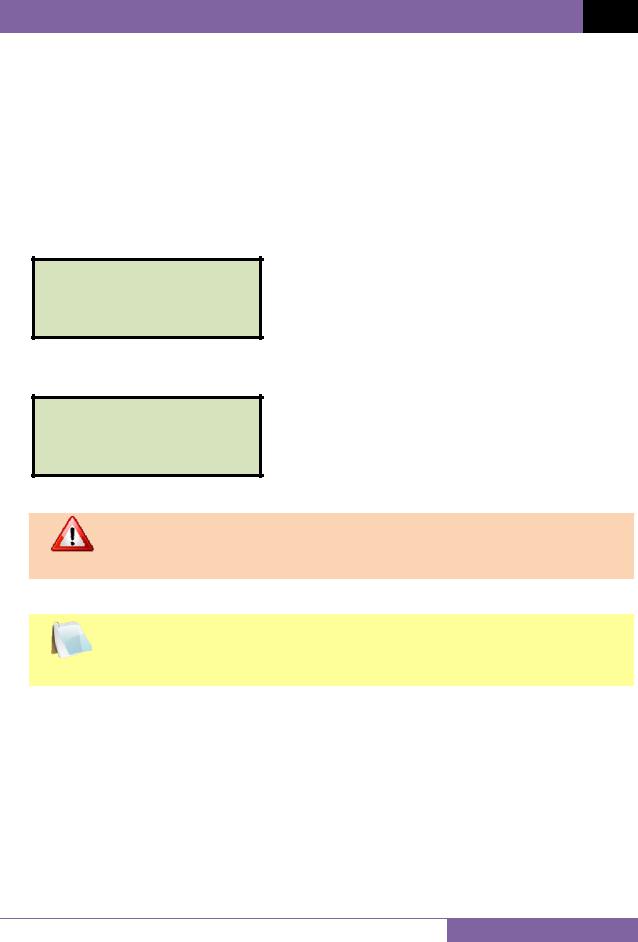
CT-7000 S2 USER’S MANUAL REV 2
CONVENTIONS USED IN THIS DOCUMENT
This document uses the following conventions:
•A key or switch on the CT-7000 S2 is indicated as [KEY] and [SWITCH].
•Menu options are referenced as (MENU OPTION).
•Screen and menu names are referenced as “SCREEN/MENU NAME”.
•The terms “test record” and “test shot” are used interchangeably.
•CT-7000 S2 LCD screen output is shown as:
1.OPTION 1
2.OPTION 2
3.OPTION 3
4.OPTION 4
•When instructions are provided, the menu item that should be selected is shown in bold as shown below (option 3 should be selected):
1.OPTION 1
2.OPTION 2
3.OPTION 3
4.OPTION 4
•Warning messages are indicated as:
Warning message
WARNING
•Important notes are indicated as:
Note details
NOTE
1

REV 2 CT-7000 S2 USER’S MANUAL
1.0INTRODUCTION
1.1General Description and Features
The CT-7000 S2 is Vanguard’s third generation, stand-alone, microprocessor-driven EHV circuitbreaker analyzer. This inexpensive and easy to use analyzer is available in models with either 3 (CT-7000-3 S2), 6 (CT-7000-6 S2), or 12 (CT-7000-12 S2) dry-contact inputs. The CT-7000 S2 can fully analyze a circuit-breaker’s performance by testing the contact time, stroke, velocity, overtravel, and contact wipe. Contact-motion analysis can be performed for all breaker contact operations (Open, Close, Open – Close, Close – Open, and Open – Close – Open). The CT-7000 S2’s timing window is selectable between 1-second, 10-second, or 20-second periods. The 10second and 20-second timing windows are ideal for timing long duration events such as circuitswitcher contact testing.
Contact Timing Inputs
Dry-contact input channels are used for timing circuit-breaker contacts. Each contact input channel can detect main contact and insertion-resistor contact times in milliseconds and cycles.
Voltage Monitoring Inputs
One analog voltage input channel is dedicated to monitoring a circuit-breaker’s DC power supply or coil voltage (0 – 255 volts, DC or peak AC). One digital voltage input channel is dedicated to detecting the voltage on/off status (presence or absence) of an A/B switch.
Trip/Close Current Monitoring
A built-in Hall-effect current sensor records the Trip/Close current level and duration. The breaker’s operating-coil current waveform duration (effectively, a performance "fingerprint" or "current profile") can be used as a diagnostic tool for analyzing a breaker’s performance.
Breaker Stroke and Velocity
Three digital travel transducer channels are available on the CT-7000 S2 for measuring circuitbreaker velocity, stroke, over-travel, and bounce-back. Unlike other transducer types, the digital transducer requires neither calibration nor setup. A breaker’s contact-velocity is calculated based on the contact’s travel distance over a period of time. The CT-7000 S2 can also perform a special “slow-close” test that can measure the circuit breaker contact touch and contact wipe.
Resistor Type Transducer Input
One optional resistor type input channel is also available on the CT-7000 S2. This input channel allows the unit to measure circuit-breaker motion by directly interfacing with resistive type transducers. The transducer resistance ranges from 200 ohms to 10K Ohms.
Breaker Initiate Features
A built-in solid-state initiate device is used to operate a breaker from the CT-7000 S2. The operational modes include Open, Close, Open – Close, Close – Open, and Open – Close – Open. Multiple operations, such as Open – Close and Open – Close – Open, can be initiated by using programmable delay time or by sensing a breaker’s contact condition.
2

CT-7000 S2 USER’S MANUAL REV 2
Internal Test Record Storage
The CT-7000 S2 can store up to 150 test records in Flash EEPROM. Test records can be retrieved and printed on the built-in thermal printer, or they can be transferred to a PC via the unit’s RS232C or USB interface.
Internal Breaker Test Plan Storage
The CT-7000 S2 can store up to 99 circuit-breaker test plans. Test plans are comprised of all circuit-breaker performance specifications (stroke, velocity, and contact time). A test plan can be used to immediately test a circuit-breaker. A pass/fail report is then generated by comparing actual performance with the specifications in the stored test plan. Test plans can also be generated on a PC and transferred to the CT-7000 S2 via the unit’s RS-232C or USB interface.
Computer Interface
The CT-7000 S2 can be computer-controlled via its RS-232C or USB interface. A Windows® XP/Vista/7-compatible Breaker-Analysis software application is provided with each unit. Using this software, circuit-breakers can be timed from the PC. Test records can be retrieved from the CT-7000 S2 and then stored on the PC for future analysis and report generation. Circuit-breaker test plans can also be created on the PC and transferred to the CT-7000 S2. Additionally, test records can be exported in Microsoft® Excel format for further analysis.
Diagnostic Capabilities
The CT-7000 S2 can perform diagnostics on its internal electronics. Diagnostics can be performed to verify contact cable connections and to test the travel transducer’s electronics.
User Interface
The CT-7000 S2 features a back-lit LCD screen (20 characters by 4 lines) that is viewable in both bright sunlight and low-light levels. A rugged, 16-key, membrane keypad is used to control the unit.
Built-in Thermal Printer
The CT-7000 S2’s built-in 4.5-inch wide thermal printer can print the breaker contact analysis results in both tabular and graphic formats.
3

REV 2 CT-7000 S2 USER’S MANUAL
1.2Technical Specifications
Table 1. CT-7000 S2 Technical Specifications
TYPE |
Portable circuit-breaker analyzer |
|
PHYSICAL SPECIFICATIONS |
16”W X 11”H x 14”D (40.6 cm x 29.9 cm x 35.6 cm); Weight: less than 25 lbs (11.3 kg) |
|
INPUT POWER |
100 – 120 Vac or 200 – 240 Vac (selectable), 50/60Hz |
|
DRY-CONTACT INPUT |
3, 6 or 12 dry-input channels (depending on model). Each channel detects main and |
|
|
insertion-resistor contacts |
|
TIMING WINDOWS |
1-second, 10-seconds, or 20-seconds |
|
TIMING RESOLUTIONS |
±50 micro-seconds @ 1-second duration, |
|
|
±500 micro-seconds @ 10-second duration, |
|
|
±1.0 milli-seconds @ 20-second duration |
|
|
|
|
TIMING ACCURACY |
0.05% of reading ±0.05 ms @ 1-second duration |
|
DRY-CONTACT CHANNEL |
All contact inputs are grounded until test; input channels are protected against static |
|
PROTECTION |
discharge |
|
DRY-CONTACT DETECTION |
Closed: less than 20 ohms; |
|
RANGE |
Open: greater than 5,000 ohms |
|
RESISTOR DETECTION RANGE |
50 – 5,000 ohms |
|
|
|
|
TRIGGER INPUT VOLTAGE |
Open/Close: 30 – 300V, DC or peak AC |
|
VOLTAGE SENSING INPUT |
V1: analog input; 0 – 255V DC or peak AC; Sensitivity ±1V |
|
RANGE |
V2: voltage presence/absence detector input; 30 – 300V DC or peak AC |
|
|
|
|
BREAKER OPERATIONS |
Initiate Open, Close, Open– Close, Close – Open, Open – Close – Open |
|
BREAKER INITIATE CAPACITY |
30A, 250Vac/dc max |
|
|
|
|
INITIATE CURRENT READING |
One, non-contact, Hall-effect sensor, 0 – 20 amp range, dc to 5Khz |
|
RANGE |
|
|
DIGITAL TRAVEL TRANSDUCER |
3 digital travel transducer channels; Linear range, 0.0 – 60.0 in (±0.01 in); Rotary |
|
INPUTS |
range: 0 – 360 degrees (±0.36 degrees) |
|
OPTIONAL RESISTOR TYPE |
200 Ohms – 10K Ohms |
|
TRANSDUCER INPUT |
|
|
CONTACT TRAVEL POINT |
Measures “slow-close” contact-point distances; results can be printed |
|
DIFFERENCE |
|
|
DISPLAY |
Back-lit LCD Screen (20 characters by 4 lines); viewable in bright sunlight and low-light |
|
|
levels |
|
PRINTER |
Built-in 4.5-inch wide thermal printer can print both graphic contact travel waveforms |
|
|
and tabulated test results |
|
INTERNAL TEST RECORD |
Stores up to 150 test records and 99 test plans |
|
STORAGE |
|
|
COMPUTER INTERFACES |
One RS-232C port, One USB port |
|
|
|
|
PC SOFTWARE |
Windows® XP/Vista/7-based Breaker-Analysis software is included with purchase price |
|
SAFETY |
Designed to meet UL 6101A-1 and CAN/CSA C22.2 No 1010.1-92 standards |
|
|
|
|
ENVIRONMENT |
Operating: -10°C to 50°C (+15°F to +122°F); Storage: -30°C to70°C (-22°F to +158°F) |
|
HUMIDITY (MAX) |
90% RH @ 40˚ C (104˚ F) non-condensing |
|
|
|
|
ALTITUDE (MAX) |
2000m (6562 ft) to fully safety specifications |
|
OPTIONS |
Transportation case (available for the CT-7000 S2 and the travel transducers) |
|
|
|
|
WARRANTY |
One year on parts and labor |
|
|
|
|
The above specifications are valid at nominal operating voltage and at a temperature of 25°C (77°F). Specifications may change without prior notice.
NOTE
4
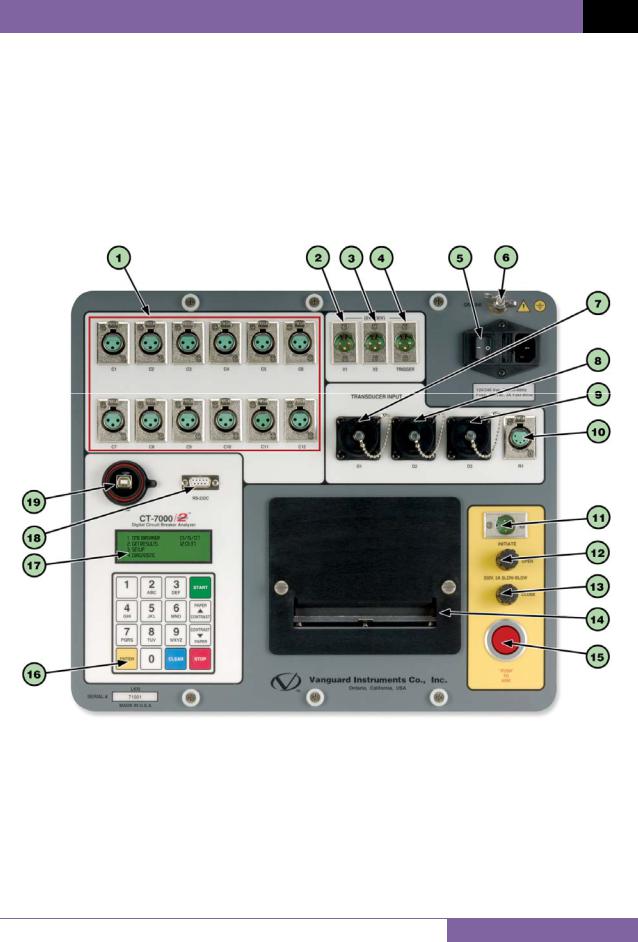
CT-7000 S2 USER’S MANUAL REV 2
1.3CT-7000 S2 Controls and Indicators
The CT-7000 S2’s controls and indicators are shown in Figure 1 below. A leader line with an index number points to each control and indicator, which is cross-referenced to a functional description in Table 2. The table describes the function of each item on the control panel. The purpose of the controls and indicators may seem obvious, but users should become familiar with them before using the CT-7000 S2. Accidental misuse of the controls will usually cause no serious harm. Users should also be familiar with the safety summary found on the front page of this User’s Manual.
Figure 1. CT-7000 S2 Controls and Indicators
5

REV 2 CT-7000 S2 USER’S MANUAL
Table 2. Functional Descriptions of CT-7000 S2 Controls and Indicators
Item |
Panel Markings |
|
Functional Description |
Number |
|
||
1 |
C1-C12 |
|
Female connectors for the contact channels. The CT-7000-12 S2 is pictured |
|
|
|
with 12 channels. |
2 |
0-300V |
|
3-pin connector. V1 voltage input channel is dedicated to monitoring circuit |
|
V1 |
|
breaker DC power supply or coil voltages. Voltage sensing range is from 0-255 |
|
|
|
volts, dc or peak ac. |
3 |
0-300V |
|
3-pin connector. V2 voltage input channel is dedicated to detecting voltage |
|
V2 |
|
on/off status (present or absent) of an A/B switch. Voltage input ranges from |
|
|
|
0-300 volts, dc or peak ac. |
4 |
0-300V |
|
3-pin connector. Triggers voltage input for external trigger application. Voltage |
|
TRIGGER |
|
levels ranging from 30 to 300 V, dc or peak ac. |
5 |
100-120 Vac, 8A, |
|
Power plug and power switch. Built-in 12 Ampere circuit breaker. |
|
50-60Hz |
|
|
6 |
GROUND |
|
Safety ground terminal. |
7, 8, 9 |
D1, D2, D3 |
|
16-pin connectors. Digital travel transducer input channels. |
|
TRANSDUCER |
|
|
|
INPUT |
|
|
10 |
R1 |
|
5-pin connector. Resistor type transducer input. (Optional) |
|
|
|
|
11 |
INITIATE |
|
4-pin connector used for the switching circuit for operating the circuit breaker |
|
|
|
under test. |
12 |
OPEN |
|
Open circuit fuse: 5 Ampere, 250V, SLOW-BLOW. |
|
250V, |
|
|
|
5A SLOW-BLOW |
|
|
13 |
CLOSE |
|
Close circuit fuse: 5 Ampere, 250V, SLOW-BLOW. |
|
250V, |
|
|
|
5A SLOW-BLOW |
|
|
14 |
|
|
Built-in 4.5-inch wide thermal printer. |
|
|
|
|
15 |
“PUSH” TO ARM |
|
Spring-loaded pushbutton switch. Press and hold to complete the Trip or Close |
|
|
|
circuits for breaker tests. |
16 |
|
|
Rugged alpha-numeric membrane keypad. |
|
|
|
|
17 |
|
|
Back-lit LCD screen (20 characters by 4 lines); viewable in bright sunlight and |
|
|
|
low-light levels. |
18 |
RS-232C |
|
RS-232C serial computer interface port. |
19 |
USB |
|
USB computer interface port. |
|
|
|
|
6

CT-7000 S2 USER’S MANUAL REV 2
2.0PRE-TEST SETUP
2.1Operating Voltages
The CT-7000 S2’s operating voltage is selectable between 110-120 Vac, 50/60 Hz and 220-240 Vac, 50/60 Hz. In older production models of the CT-7000 S2, the operating voltage is set by the voltage selection switch as shown in Figure 2. To change the voltage setting, remove the CT7000 S2 from its enclosure, locate the voltage setting switch on the right side of the unit, and set the new operating voltage. Newer production models of the CT-7000 S2 can auto-sense the voltage and do not have a voltage selection switch.
Figure 2. CT-7000 S2 Operating Voltage Setting Switch
2.2LCD Screen Contrast Control
To increase the LCD screen contrast, press and hold the [PAPER Contrast] key for two seconds. Release the button when the desired contrast level has been reached.
To decrease the LCD screen contrast, press and hold the [PAPER Contrast] key for two seconds. Release the button when the desired contrast level has been reached.
7

REV 2 CT-7000 S2 USER’S MANUAL
2.3Printer Paper Control
To advance the thermal printer paper, press and release the [PAPER Contrast] key. To retract the thermal printer paper, press and release the [PAPER Contrast] key.
2.4Printer Paper
The CT-7000 S2’s built-in thermal printer uses 4.5-inch wide thermal paper for printing test results. To maintain the highest print quality and to avoid paper jams, the use of thermal paper supplied by Vanguard Instruments Company is highly recommended. Additional paper can be ordered from the following sources:
Vanguard Instruments Co, Inc.
1520 S. Hellman Avenue Ontario, CA 91761
Tel: 909-923-9390
Fax: 909-923-9391
Part Number: VIC TP-4 paper
BG Instrument Co.
13607 E. Trent Avenue Spokane, WA 99216 Tel: 509-893-9881 Fax: 509-893-9803
Part Number: VIC TP-4 paper
2.5Replacing the Thermal Printer Paper
The roll of thermal paper is housed inside a dispenser underneath the printer cover. To replace the paper, follow the steps below:
•Unscrew the two large printer cover screws and remove the printer cover.
•Remove the leftover thermal paper roll from the paper holder.
•Unroll the new thermal paper roll.
•Feed the thermal paper into the slot between the paper pocket and the rubber roller. The printer will automatically pull the paper under the thermal head.
•Place the paper roll into the paper holder.
•Lift the thermal head and align the thermal paper if necessary.
•Re-install the printer cover.
Thermal paper has a chemical coating on one side of the paper. This side should be facing the thermal print head. Incorrect paper loading may result in blank output on
the thermal paper.
NOTE
The thermal paper will show a red stripe to indicate that the roll is about to run out of paper.
8
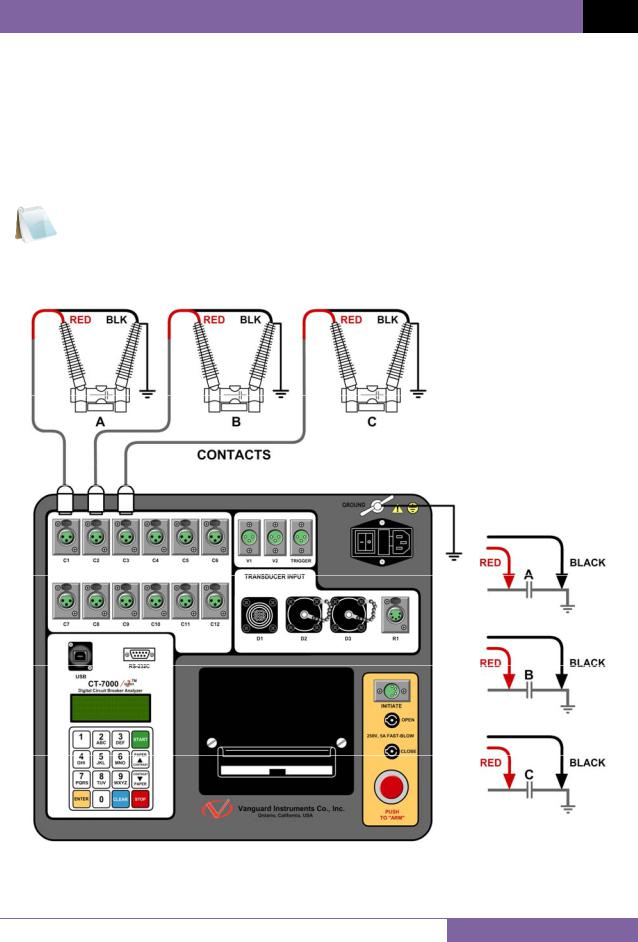
CT-7000 S2 USER’S MANUAL REV 2
3.0OPERATING PROCEDURES
3.1Cable Connections
3.1.1. Contact Cable Connections
A typical contact cable connection to a circuit breaker is shown in Figure 3. Red and black clips are connected across the circuit contact phases A, B, and C. A typical circuit breaker with series contacts is shown in Figure 4.
|
|
It is advisable to ground one side of the contacts for most testing purposes. If a |
|
|
breaker is floating or un-grounded, ensure that the contact channel inputs are |
|
NOTE |
protected against static discharge. |
|
|
|
|
|
|
Figure 3. Typical 3-Phase Circuit Breaker Connections
9
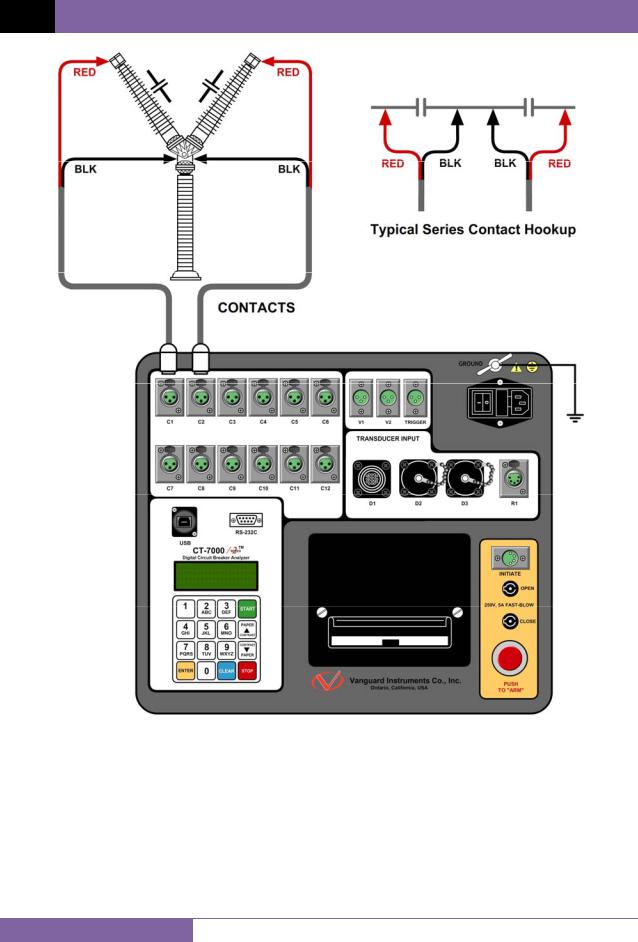
REV 2 CT-7000 S2 USER’S MANUAL
Figure 4. Typical Connections for Series Contact Circuit Breaker
10
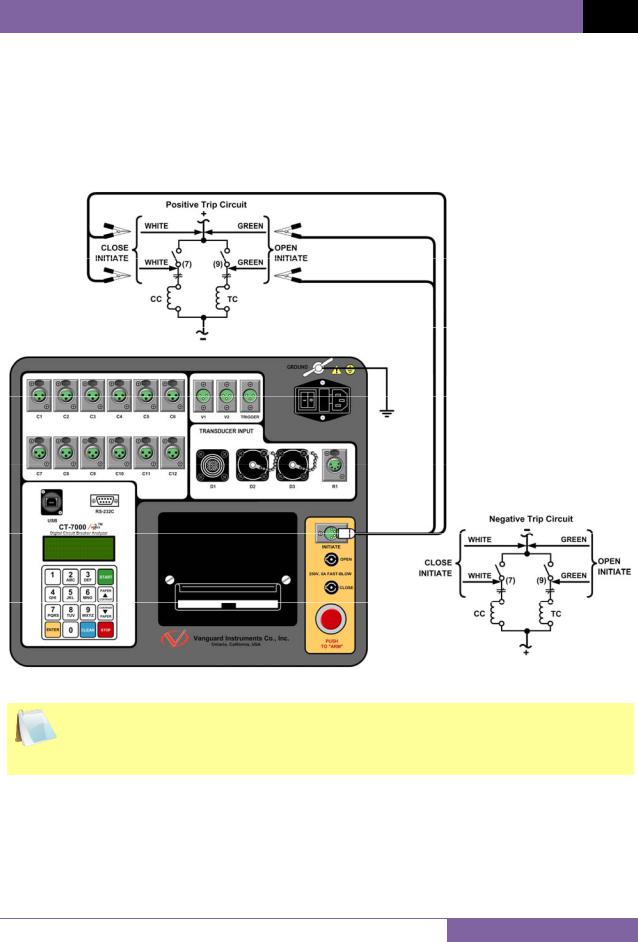
CT-7000 S2 USER’S MANUAL REV 2
3.1.2. Initiate Cable Connections
The CT-7000 S2 can trip or close breakers through a solid-state device operating on any AC or DC control voltage ranging from 10 to 300 Volts. Both the trip and close circuits are protected by 5 Ampere fuses. A typical DC trip and DC close control circuit connection is shown in Figure 5. A typical DC trip and AC close control circuit connection is shown in Figure 6.
Figure 5. Typical DC Trip and DC Close Control Circuit Connection
Auxiliary switches, in series with the OPEN and CLOSE coil control circuit, are used to
interrupt the coil current.
NOTE
11
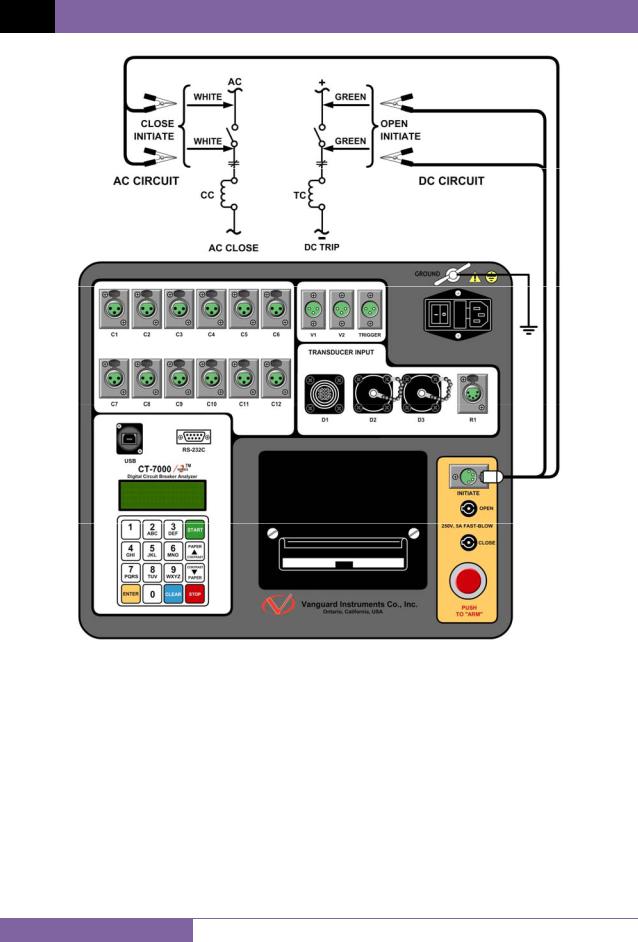
REV 2 CT-7000 S2 USER’S MANUAL
Figure 6. Typical DC Trip and AC Close Control Circuit Connection
12
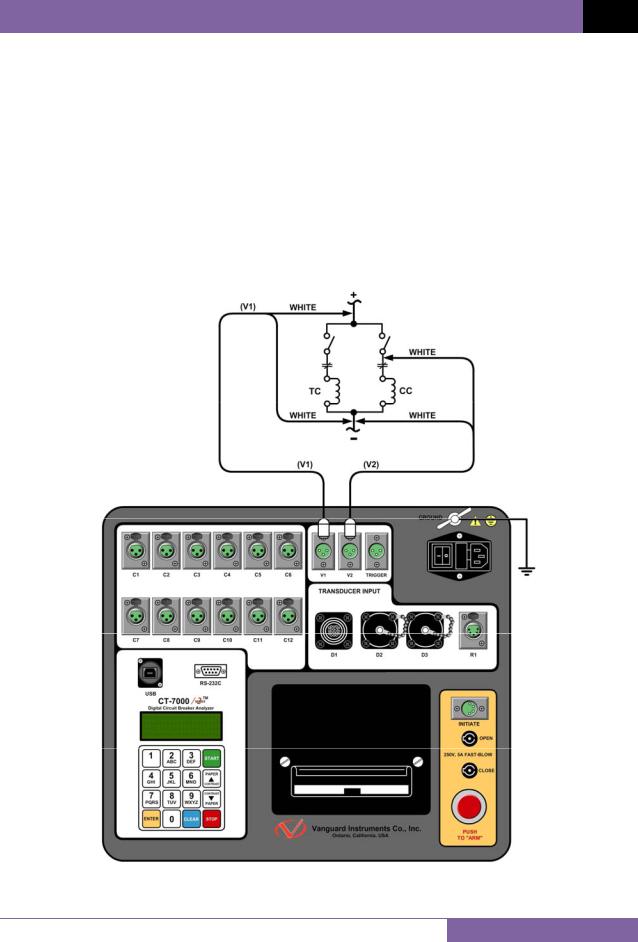
CT-7000 S2 USER’S MANUAL REV 2
3.1.3. Analog and Digital Voltage Monitoring Connections
The analog voltage input “V1” can monitor a breaker’s DC control voltage during an operation. The analog voltage input records the nominal DC voltage at no load and the minimum DC voltage while the Trip or Close coil is energized. The nominal and minimal voltage readings are printed on a tabulated report, and the analog waveforms are plotted in graphical format. This allows the user to see the breaker’s DC control voltage “dip” under load conditions and helps detect problems such as a poor connection or an excessive voltage drop during operation. Please note that the maximum voltage that can be recorded is 255 Vdc.
The digital voltage input channel “V2” can monitor the voltage status as “ON” or “OFF” states. The voltage “ON” or “OFF” states are plotted on the graphical report. Typical analog (“V1”) and digital (“V2”) voltage monitoring connections are shown in Figure 7.
Figure 7. Typical Analog and Digital Voltage Monitoring Connections
13
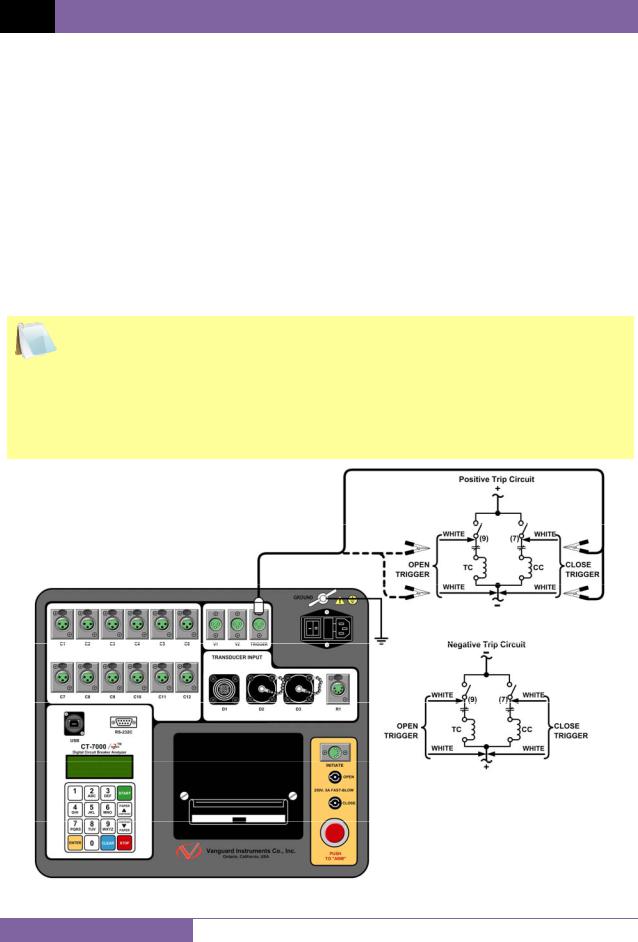
REV 2 CT-7000 S2 USER’S MANUAL
3.1.4. External Trigger Input Connections
The External Trigger Mode can be used to start recording data when the CT-7000 S2 senses a voltage. A typical application for the External Trigger Mode is to time a circuit breaker in a Close operation and to start timing only when the Close coil is energized, thus bypassing the 52X relay delay time.
Since the 52X relay carries the Close coil current, the CT-7000 S2’s initiate cable must be connected to the Close terminal as shown in Figure 5. The CT-7000 S2 will energize the 52X relay to start the Close operation, which will then start the timing when the CT-7000 S2 senses the voltage across the closing coil. Typical external trigger input connections are shown in Figure 8.
Another application for the External Trigger is to start timing the breaker when the user trips or closes the breaker remotely.
• The minimum trigger voltage is 30 Vac/dc. Maximum, continuous voltage is limited to 300 Vac/dc. Different trigger voltages can be set at the factory by request.
NOTES
• The CT-7000 S2 will start looking for the external trigger voltage when the message “AWAITING TRIGGER…” is displayed on the LCD screen. The external trigger voltage must be sensed by the CT-7000 S2 within 15 seconds after the initiate sequence has begun. The CT-7000 S2 will return to the “START-UP” menu if no voltage is sensed.
Figure 8. Typical External Trigger Input Cable Connections
14
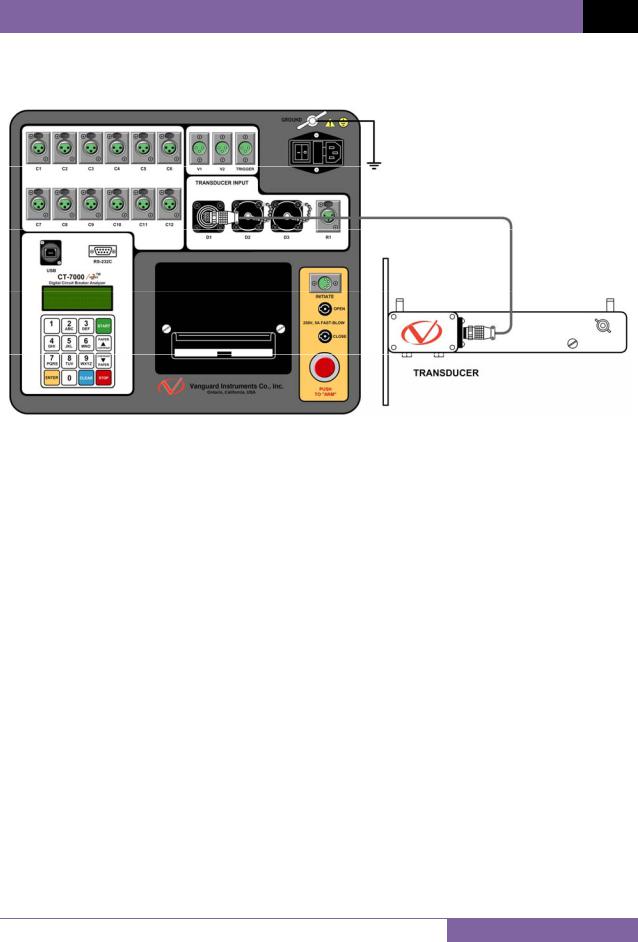
CT-7000 S2 USER’S MANUAL REV 2
3.1.5. Digital Transducer Connection
A typical digital transducer connection is shown in Figure 9.
Figure 9. Typical Digital Transducer Connection
15

REV 2 CT-7000 S2 USER’S MANUAL
3.1.6. Resistor Type Transducer Connection
The CT-7000 S2 provides one channel for resistor type transducers. The transducer resistance input can range from 200 Ohms to 10K Ohms. The CT-7000 S2 supplies a 5 Vdc reference voltage to power the resistor type transducer. The sense voltage is translated into a travel distance based on the transducer calibration parameters. The user is required to setup the resistor transducer before performing a test. Up to nine transducer setups can be stored in the CT-7000 S2’s internal memory. Once a transducer setup is stored, it can be recalled quickly before running a test. A typical resistor type transducer connection is shown in Figure 10.
• When a resistor type transducer is used, the test results are shown as travel transducer channel 1 (see Figure 15).
NOTES
• A 15-foot transducer cable with 3 quick disconnect clips is provided with each CT7000 S2. The 3 clips are labeled “+5V”, “Signal”, and “GND”.
•See section 3.1.18 for resistor type transducer calibration information.
Figure 10. Typical Resistor Type Transducer Connection
16
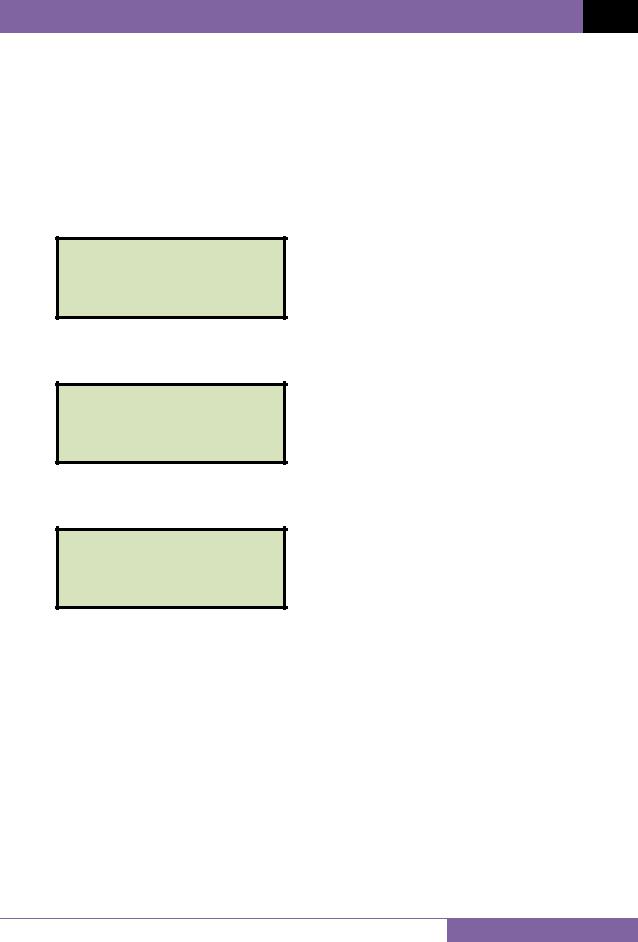
CT-7000 S2 USER’S MANUAL REV 2
3.1.7.Pre-Test Setup
3.1.8.Entering Test Record Header Information
You can enter the test record header information before performing tests. The record header includes identifying information such as the company, station, circuit, model number, etc. Once the header information has been entered, it will apply to all subsequent test records. To enter the header information:
a.When the unit is turned on and the firmware is loaded, you will be presented with the “START-UP” menu as shown below:
1.TIME BRKR 02/03/11
2.GET RSLT 09:04:05
3.SETUP
4.DIAGNOSTICS
Press the [3] key (SETUP).
b.The following screen will be displayed:
1.ANALYSIS POINTS
2.MEASUREMENT UNITS
3.SAVE / RESTORE
4.NEXT PAGE
Press the [4] key (NEXT PAGE).
c.The following screen will be displayed:
1.SHOT DESCRIPTION
2.NUMBER OF CHANNELS
3.SET DATE & TIME
4.NEXT PAGE
Press the [1] key (SHOT DESCRIPTION).
17
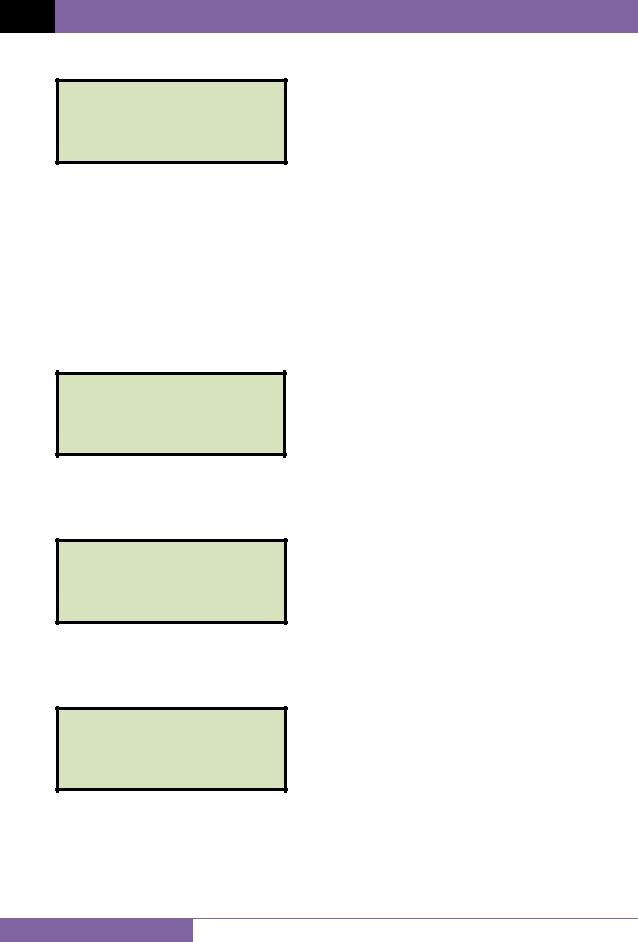
REV 2 CT-7000 S2 USER’S MANUAL
d. The following screen will be displayed:
COMPANY:
↑↓ TO POSITION “ENTER” TO ACCEPT
Type the company name using the alpha-numeric keypad.
When pressing a key, the corresponding number on the key will be displayed first. Pressing the key again will display the first letter on the key. Pressing the key again will
display the second letter on the key. For example, to type the letter “A”, you must press the [2] key twice. To erase the character at the cursor position, press the [CLEAR] key. Press the [PAPER Contrast] key to move to the next character. Press the [PAPERContrast] key to move to the previous character. Press the [ENTER] key when you
are done typing the company name.
e. The following screen will be displayed:
STATION:
↑↓ TO POSITION “ENTER” TO ACCEPT
Type the station name using the alpha-numeric keypad and then press the [ENTER] key.
f. The following screen will be displayed:
CIRCUIT:
↑↓ TO POSITION “ENTER” TO ACCEPT
Type the circuit information using the alpha-numeric keypad and then press the
[ENTER] key.
g. The following screen will be displayed:
MANUFACTURER:
↑↓ TO POSITION “ENTER” TO ACCEPT
Type the manufacturer name using the alpha-numeric keypad and then press the
[ENTER] key.
18
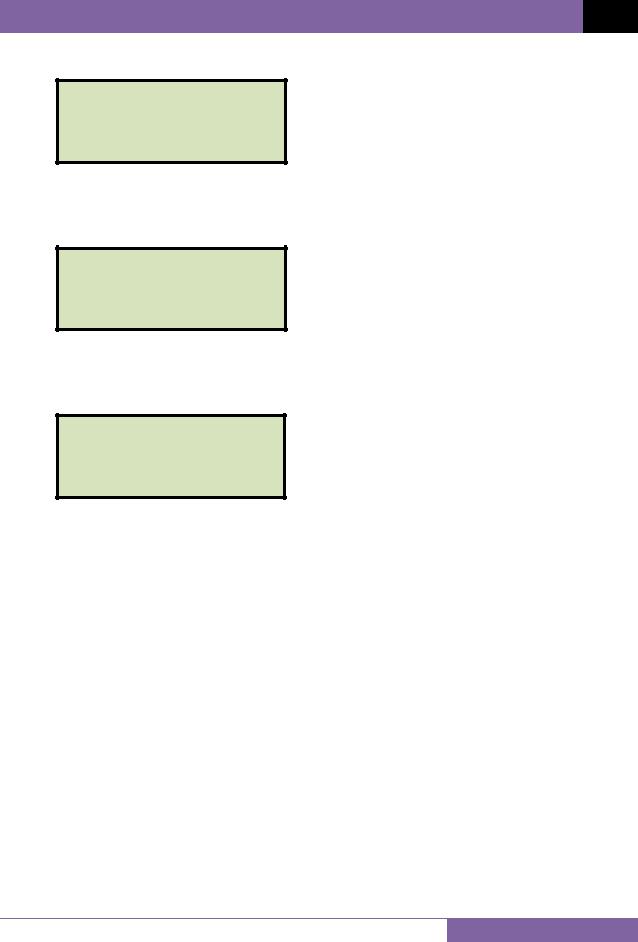
CT-7000 S2 USER’S MANUAL REV 2
h. The following screen will be displayed:
MODEL:
↑↓ TO POSITION “ENTER” TO ACCEPT
Type the model information using the alpha-numeric keypad and then press the
[ENTER] key.
i. The following screen will be displayed:
SERIAL NUMBER:
↑↓ TO POSITION “ENTER” TO ACCEPT
Type the serial number using the alpha-numeric keypad and then press the [ENTER] key.
j. The following screen will be displayed:
OPERATOR:
↑↓ TO POSITION “ENTER” TO ACCEPT
Type the operator’s name using the alpha-numeric keypad and then press the [ENTER] key. All header information will be saved, and you will be returned to the “START-UP” menu.
19
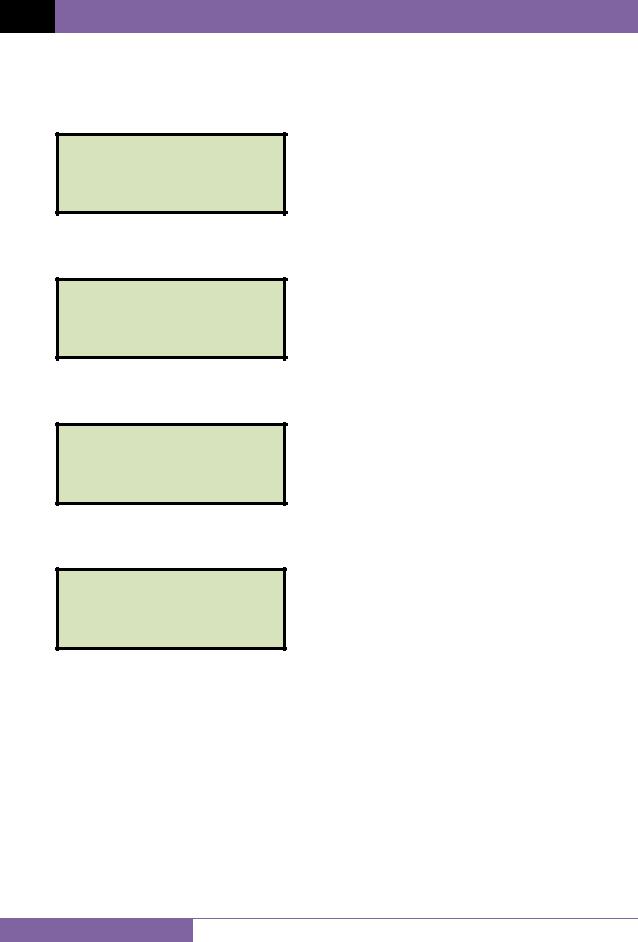
REV 2 CT-7000 S2 USER’S MANUAL
3.1.9. Setting the Clock
To set the CT-7000 S2’s internal clock:
a.Start from the “START-UP” menu:
1.TIME BRKR 02/03/11
2.GET RSLT 09:04:05
3.SETUP
4.DIAGNOSTICS
Press the [3] key (SETUP).
b.The following screen will be displayed:
1.ANALYSIS POINTS
2.MEASUREMENT UNITS
3.SAVE / RESTORE
4.NEXT PAGE
Press the [4] key (NEXT PAGE).
c.The following screen will be displayed:
1.SHOT DESCRIPTION
2.NUMBER OF CHANNELS
3.SET DATE & TIME
4.NEXT PAGE
Press the [3] key (SET DATE & TIME).
d. The following screen will be displayed:
ENTER
MM-DD-YY HH:MM:SS
Enter the month, date, time, hours, minutes, and seconds (in 24-hour format) using the alpha-numeric keypad. When the last digit is entered, the clock will be set and you will be returned to the “START-UP” menu.
20
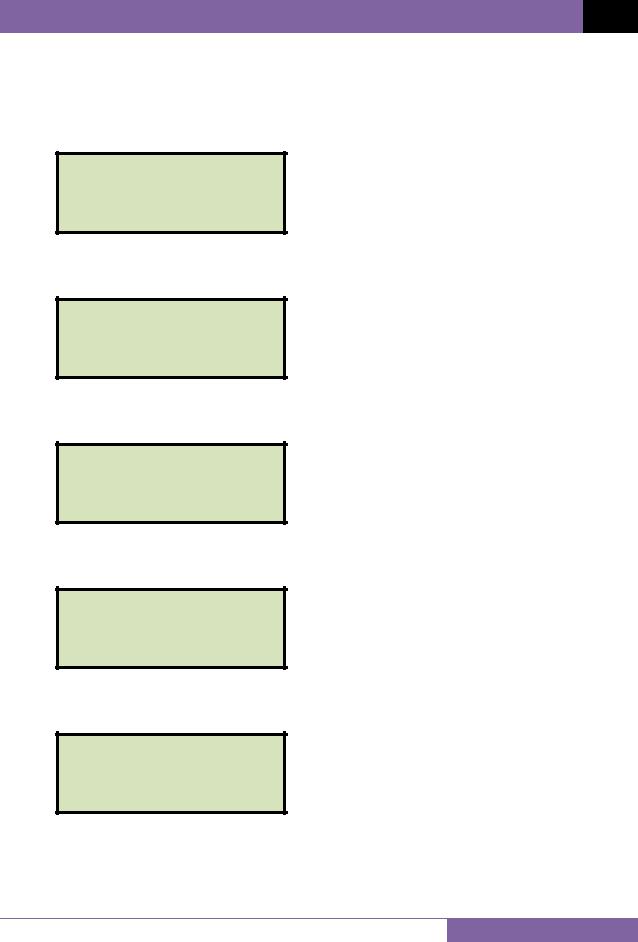
CT-7000 S2 USER’S MANUAL REV 2
3.1.10. Configuring the Automatic Printing Feature
The CT-7000 S2 can be configured to print graphs and tabulated results automatically after each test. To configure the automatic printing feature:
a.Start from the “START-UP” menu:
1.TIME BRKR 02/04/11
2.GET RSLT 13:29:15
3.SETUP
4.DIAGNOSTICS
Press the [3] key (SETUP).
b.The following screen will be displayed:
1.ANALYSIS POINTS
2.MEASUREMENT UNITS
3.SAVE / RESTORE
4.NEXT PAGE
Press the [4] key (NEXT PAGE).
c.The following screen will be displayed:
1.SHOT DESCRIPTION
2.NUMBER OF CHANNELS
3.SET DATE & TIME
4.NEXT PAGE
Press the [4] key (NEXT PAGE).
d.The following screen will be displayed:
1.SET PRINT MODE
2.SET 50/60 Hz
Press the [1] key (SET PRINT MODE).
e. The following screen will be displayed:
SET PRINT MODE:
1.AUTOMATIC PRINT
2.BY REQUEST ONLY
Press the [1] key (AUTOMATIC PRINT) if you would like to automatically print tabulated and graphic results after each test is performed.
Press the [2] key (BY REQUEST ONLY) to turn off automatic printing of test results. Please see section 3.2.5 for instructions on how to manually print test results.
21
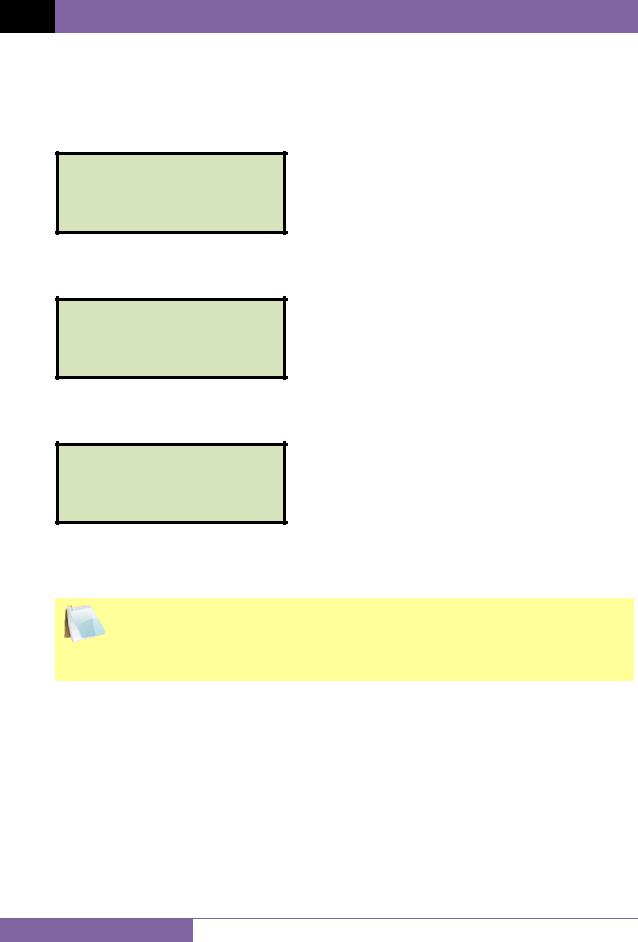
REV 2 CT-7000 S2 USER’S MANUAL
3.1.11. Setting the Units of Measure
The CT-7000 S2 supports and displays both English and Metric calculations. You can switch between the English and Metric systems using the steps below:
a.Start from the “START-UP” menu:
1.TIME BRKR 02/04/11
2.GET RSLT 13:08:25
3.SETUP
4.DIAGNOSTICS
Press the [3] key (SETUP).
b.The following screen will be displayed:
1.ANALYSIS POINTS
2.MEASUREMENT UNITS
3.SAVE / RESTORE
4.NEXT PAGE
Press the [2] key (MEASUREMENT UNITS).
c. The following screen will be displayed:
SELECT UNITS:
1.ENGLISH
2.METRIC
3.ROTARY ENCODER
Press the [1] key (ENGLISH) or the [2] key (METRIC) to select the corresponding measurement system. The measurement system will be set and you will be returned to the “START-UP” menu.
If the measurement system is changed, any relevant values in the working memory will be automatically converted to the new system. Also, if retrieving
NOTE
a test record from the Flash EEPROM, all data will be converted to the new measurement system. There is no need to re-run a test.
22
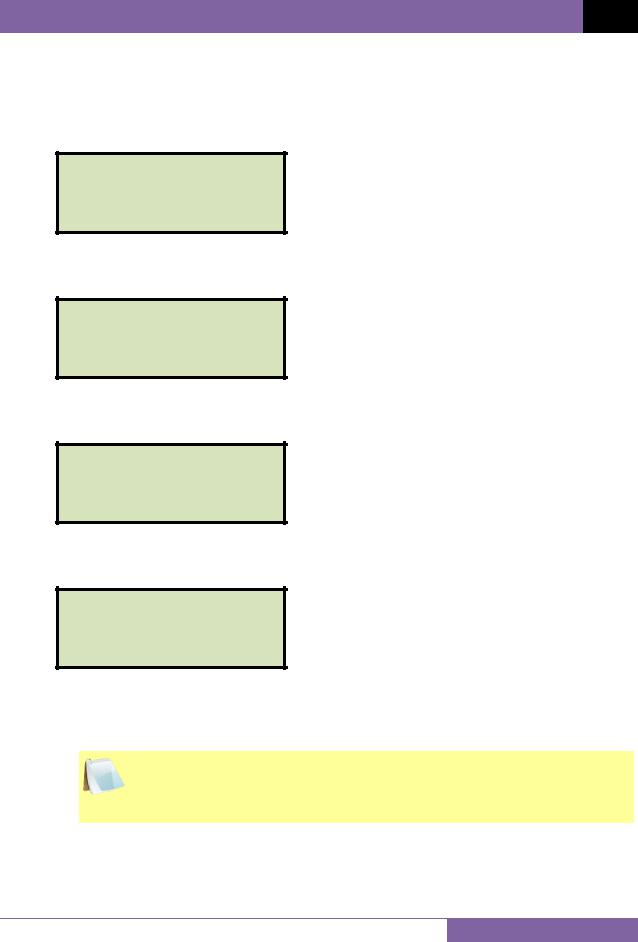
CT-7000 S2 USER’S MANUAL REV 2
3.1.12. Setting the Open Timing Analysis Points
Two analysis points are used to calculate the velocity of the circuit breaker in the open operation. To configure the OPEN timing analysis points:
a.Start from the “START-UP” menu:
1.TIME BRKR 02/04/11
2.GET RSLT 09:04:05
3.SETUP
4.DIAGNOSTICS
Press the [3] key (SETUP).
b.The following screen will be displayed:
1.ANALYSIS POINTS
2.MEASUREMENT UNITS
3.SAVE / RESTORE
4.NEXT PAGE
Press the [1] key (ANALYSIS POINTS).
c.The following screen will be displayed:
1.OPEN TIMING
2.CLOSE TIMING
3.PRINT SETTINGS
4.TEST PLANS
Press the [1] key (OPEN TIMING).
d. The following screen will be displayed:
OPEN ANALYSIS PT 1
1.PERCENT OF STROKE
2.DIST FROM CLOSE
3.CONTACT #1
1.PERCENT OF STROKE
Press the [1] key (PERCENT OF STROKE) to set the open analysis point #1 as a percentage of the total stroke value.
Percentage of stroke is the distance based upon the percentage of the total breaker’s stroke distance. The distance is always measured from the starting
NOTE point at the fully closed position of the breaker contacts.
23
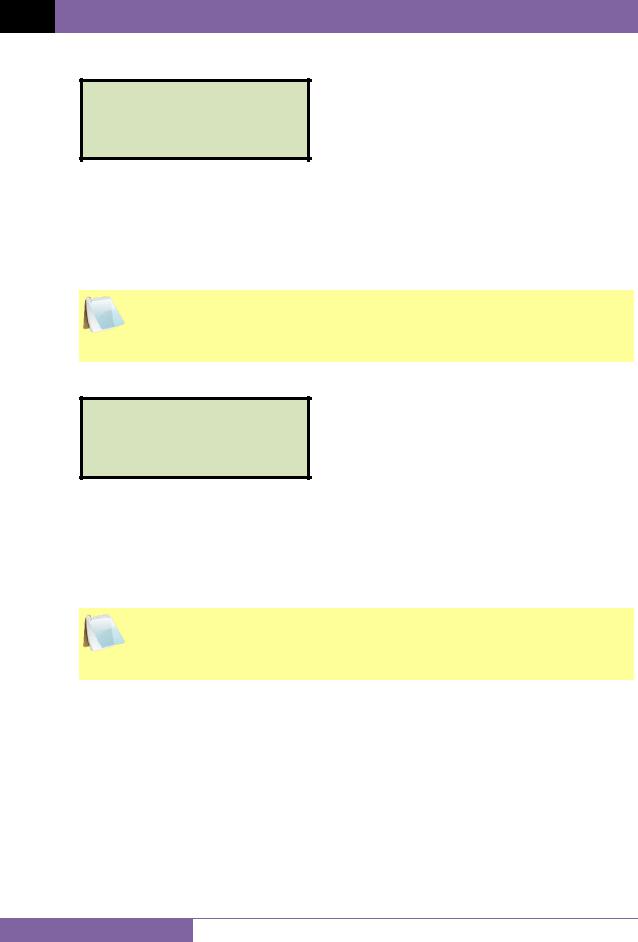
REV 2 CT-7000 S2 USER’S MANUAL
The following screen will be displayed:
OPEN ANALYSIS PT 1 % OF TOTAL STROKE VALUE: 00% “ENTER” TO CONFIRM
Type the percentage value using the numeric keypad and then press the [ENTER] key. Continue to step e.
2.DIST FROM CLOSE
Press the [2] key (DIST FROM CLOSE) to set the open analysis point #1 as a distance from the contact’s close position.
The distance from close range is selectable from 00.0 inch to 99.99 inches or from 0.0 to 999.0 millimeters. The distance is referenced from the contact’s
NOTE closed position.
The following screen will be displayed:
OPEN ANALYSIS PT 1 DISTANCE FROM CLOSE VALUE: 025.4 mm “ENTER” TO CONFIRM
Type the distance value using the numeric keypad and then press the [ENTER] key.
Continue to step e.
3.CONTACT #1
Press the [3] key (CONTACT #1) to set the open analysis point #1 value equal to the contact point #1 value. Continue to step e.
Contact point #1 is the distance from the contact’s closed position to the point where it is in transition from the CLOSE to OPEN or the OPEN to CLOSE
NOTE position.
24
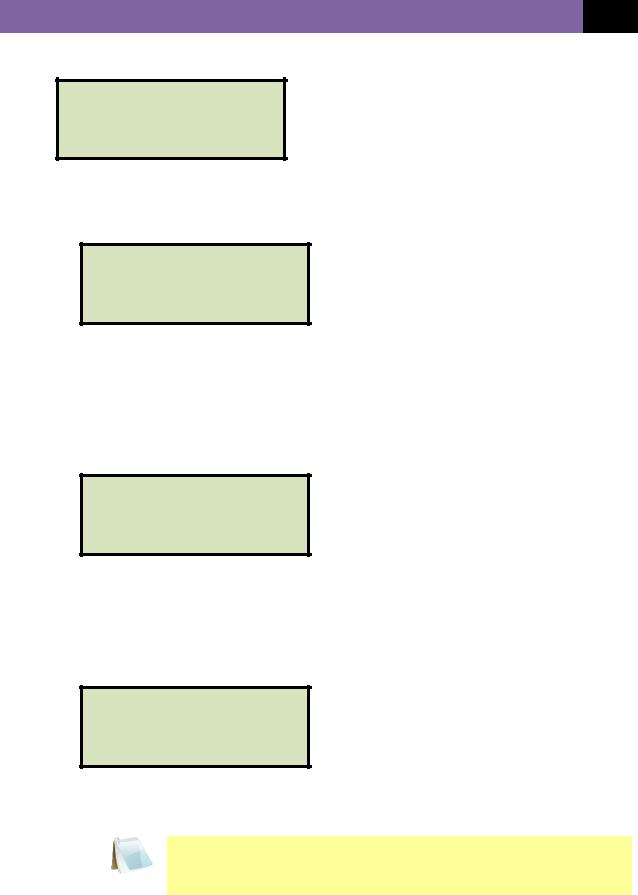
CT-7000 S2 USER’S MANUAL REV 2
e. The following screen will be displayed:
OPEN ANALYSIS PT 2
1.PERCENT OF STROKE
2.DIST FROM CLOSE
3.CONTACT +/- TIME
1.PERCENT OF STROKE
Press the [1] key (PERCENT OF STROKE) to set the open analysis point #2 as a percentage of the total stroke value. The following screen will be displayed:
OPEN ANALYSIS PT 2 % OF TOTAL STROKE VALUE: 00% “ENTER” TO CONFIRM
Type the percentage value using the numeric keypad and then press the [ENTER] key. The analysis points will be set and you will be returned to the “START-UP” menu.
2.DIST FROM CLOSE
Press the [2] key (DIST FROM CLOSE) to set the open analysis point #2 as a distance from the contact’s close position. The following screen will be displayed:
OPEN ANALYSIS PT 2 DISTANCE FROM CLOSE VALUE: 127.0 mm “ENTER” TO CONFIRM
Type the distance value using the numeric keypad and then press the [ENTER] key. The analysis points will be set and you will be returned to the “START-UP” menu.
3.CONTACT +/- TIME
Press the [3] key to select the CONTACT +/- TIME option. The following screen will be displayed:
OPEN ANALYSIS PT 2
1.CONTACT PLUS TIME
2.CONTACT MINUS TIME
1.CONTACT PLUS TIME
Press the [1] key to select the CONTACT PLUS TIME option.
|
|
For the contact plus time, the user enters the time (in milliseconds) |
|
||
|
|
after the contact channel #1 made the transition from OPEN to CLOSE |
|
||
|
NOTE |
or CLOSE to OPEN to define the analysis point #2. |
|
||
|
|
|
|
|
|
|
|
|
|
|
|
|
|
|
|
25 |
|
|
|
|
|
|
|
